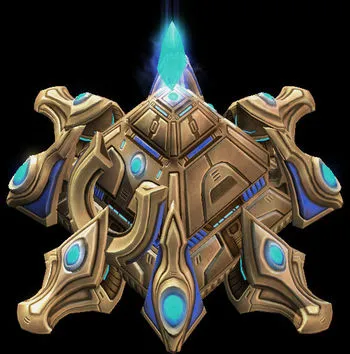I'm not sure why the @drugwars team thought it was okay to change the battle system the way they did. They took what little strategy the game had and completely stripped it away. Zero thought is now required when attacking someone; simply attack them with overwhelming force and you'll simply lose as many rowdies as they have total units (plus 4 more for every bazooka).
It literally doesn't matter what your opponent has. Pick any combination of 1000 units. If your opponent attacks you with 10,000 rowdies you lose quite decisively.
Here is a game I play every once and a while with one of my buddies. It's called Nexus Wars. It's a free-to-play game on Starcraft 2. All "Arcade" games in Starcraft 2 are free-to-play. They were created by random users with the help of the map editor.
If you spool through the video a bit, you can see that the attack range of units actually matters, as they take up 'physical' space on the playing field.
Units with longer range will attack before units with shorter range. If you have too many melee units they will start blocking themselves and not all of them can attack.
It's mechanics like these that obviously need to be in @drugwars, but instead the team just seems to flip flop between several broken battle system models. It's really hard to find an excuse for this behavior, except perhaps the "investors" of the game complained endlessly about losing all the units they purchased; so now the @drugwars team is under pressure to dumb the game down even further than it already was.
*Wars
I'm wasting far too much time with @drugwars, here's my idea for a Nexus Wars clone on the Steem blockchain. *Wars (pronounced StarWars) will be a module that can spawn multiple tug-of-war type strategy games directly on the Steem blockchain.

Why *Wars?
When you want to search for a picture file on your computer you can search for *.jpg. The result will return all JPEG files. The star is shorthand for "anything can go here". If you searched for m*.jpg it would return all JPEG files that start with the letter 'm'.
Similarly, *Wars will be able to provide a foundation for ______ Wars games. The first two I'm looking at are Nexus Wars and a tug-of-war variant of Drug Wars.
Logistics:
To start, the game will be 1v1. Imagine two bases separated by a blockchain. The blockchain is really just a linked-list/array. Each block in the chain can store a certain number of units. As time passes, units automatically move from your base to your opponents base and attempt to kill it. However, this is easier said than done, because you have to kill their units to get to the base and then kill the base (which will have several defenses).
This creates the back and forth "tug-of-war" style play where one side snowballs to the other but then the other side begins to snowball back once base defenses repel the invasion.

Options:
This module will have several options. For example, how fast does one want the game to play? For simplicity, I'll start the game off with one tick of time equal to one block, but this can change. For example, what if action happening once every three seconds was too slow from a player's perspective (probably will be). You could increase a tick of time to once per second. This means three actions would occur in between blocks instead of just one. We could take it even farther and do any number of time ticks per block. The only drawback is that players can only react on the blockchain at most once per block (3 seconds).
Blockchain
How many blocks should be in between the two bases? How many units should one block be able to accommodate? How many nukes should each player have? What are the starting resources and income and how quickly does income increase? These will all be variable options, but I'm getting ahead of myself.

Nexus Wars
Before I get way too far ahead of myself, let me give a cursory overview about how the Starcraft 2 version of Nexus Wars works. Each player starts with 100 minerals. Minerals are the only resource (*Wars will accommodate more than one, if necessary).
Each player starts with 10 income. Every 30 seconds you receive whatever income you have in minerals. If your income is 23, you get 23 minerals at the next 30 second interval.
You increase your income by making buildings. These buildings produce units constantly. For example, you might build a "spawning pool" and this would create 2 "zerglings" every 24 seconds (8 blocks). A spawning pool costs 50 minerals. Normally, for every 25 minerals you spend your income will increase by 1. Therefore, building a spawning pool costs 50 but in turn will provide you with 2 more minerals every 30 seconds for the rest of the game. There is also a special building that doesn't create units but will increase your income with higher efficiency.
Therefore, the economic strategy of the game is to increase your income as much as possible in order to overcome your opponent. However, there is also a lot of strategy about what units should be produced in order to counter your opponent's build. I'm not trying to go down that rabbit hole just yet though.
Units
Troops will have several attributes.
size
Say a block has 30 slots open for units to occupy. That doesn't mean that 30 units will be able to fit inside that block. Small units have a size of 1, in which case you could fit 30, but bigger units will take up more space. This adds some strategy to the game by implementing bottlenecks on the playing field as an exploitable resource.
armor
Mitigates damage taken. A unit with 5 armor will only take 15 damage from a raw attack of 20. Several of the games I've played have two types of armor. In Starcraft 2, there is light and heavy armor. In League of Legends, there is physical/magical mitigation. This binary solution seems to work well, as more types being added tends to overcomplicate game mechanics.
For example, a flamethrower might have a heavy bonus damage against light armored units, but they won't do much against heavily armored troops.
damage/attacks
A unit with 10 damage will 'swing' at their enemy, who will lose 10 minus their armor value. A unit with two attacks would swing twice during that time, hitting for 10 - armor twice instead of once. This variable allows units to be created that are less effective against armored units. For example, against a unit with 3 armor, troops that deal 10 damage and swing three times only do 21 damage (7*3) while they would still do the full 30 to unarmored units. Similarly, if they swung once for 30 they'd do 27 damage to 3 armor rather than the previous 21.
speed
How fast can the unit move down the lane? Speed determines this.
vitality
How much damage the unit can take before dying.
special abilities
There will be other skills available to specific units, but I'll leave that for another time.

Wow, George Lucas is going to be pissed!
Fun fact: Lucas Arts lost a lawsuit to Wicked Lasers because people were calling the lasers "lightsabers". It wasn't even Wicked Lasers calling their product this. However, once they won the lawsuit they started a marketing campaign to this effect just to troll Lucas.
This project will be open source and public domain.
Freedom of speech, yada yada yada.
I can say whatever I want as long as I'm not selling a product.
Besides, *Wars is just the foundation.
Actual frontends will be called _____ Wars (ie Drug Wars, Nexus Wars, etc.)
Conclusion
It will be interesting if I can pull it off :D My goal is to create a backend with little/no frontend graphics. Hopefully I can get more people on board after a proof-of-concept is delivered.
Return from Broken Combat + *Wars to edicted's Web3 Blog
